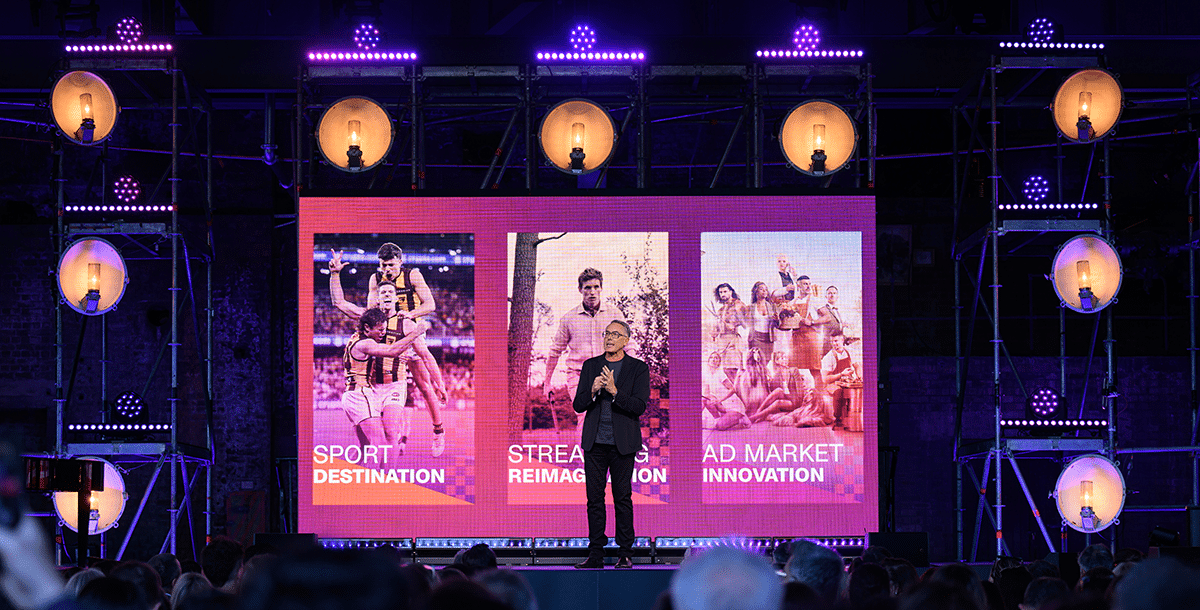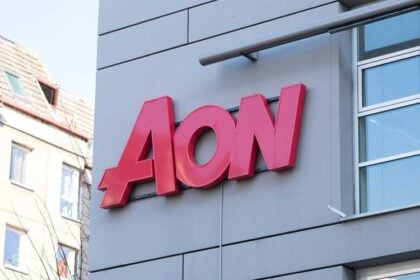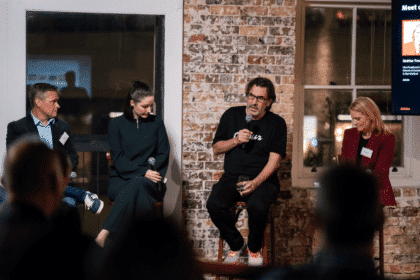Foxtel Media’s CEO pulled no punches in his opening statement to a packed Upfront ‘25 audience at Sydney’s White Bay Power Station last night.
Divorces are rarely easy, and the one between Foxtel and OzTAM is no exception. In opening last night’s Foxtel Upfront event, Foxtel Media boss Mark Frain wanted to address recent assertions by OzTAM that his business had been unwilling to collaborate with the measurement firm.
“While now is not the time for mudslinging, I do feel compelled for my team, our colleagues and our business partners, to say this publicly. We have attempted many times over the last two years to find solutions with OzTAM to address inaccuracies with the panel, to drive a more future-facing agenda, and to join as a shareholder for an equal voice,” Frain said.
“Unfortunately, the board and the shareholders said ‘no’. So we moved in a different direction, one more aligned with a consumer shift to on demand viewing, and more aligned to our business shift away from linear to digital.
“And the truth is this, in the last 12 months, Foxtel Media has progressed not by going it alone, but through a series of collaborations that are driving our business and our industry forward.”
Frain was responding to a September statement by OzTAM CEO Karen Halligan, who confirmed Foxtel would leave the measurement system at the end of this year “despite OzTAM’s best efforts” to keep them on board.
Instead, Foxtel Media will roll out its own measurement system by the end of 2025 and is collaborating with the Video Futures Collective, a group of digital video players including Amazon Advertising, Disney, Vevo, Samsung Ads, YouTube and SBS.
They are advancing talks on how to define a common language around digital video measurement as well as three research projects that aim to prove video advertising effectiveness, explore de-duplicated reach, and illustrate the power of attention and context amplification on video platforms.
“It’s not always easy,” Frain continued. “[There are] more meetings, more opinions and more compromises, but comfort and growth don’t often coexist and leadership choices are always not that popular.
“Our experience has proved collaboration is bringing greater accuracy, better results, and, more importantly, new opportunities.”

‘We’re Now A Digital-First Company’
For the past seven years, Foxtel has rapidly transitioned away from being a set top box TV broadcaster to a digital media company in its own right, including the launch of its SVODs BINGE and Kayo, which now have 1.6 million subscribers each.
Foxtel said that 52 per cent of its business and volume is now digital, placing it well ahead of other legacy TV broadcasters in this market that are on a digital transformation journey.
That was one of the key messages from last night.
Per Foxtel CEO Patrick Delany, “For seven years I’ve been coming out and talking about our progress towards becoming a digital first company. Every year we talk about our digital transformation, how we got from a single product company with a desktop box to an IP-connected digitally-led entertainment company.
“And everyone that comes out tonight, I stand before you because we are now a digital sports and entertainment company. There’s no question about it and we’re very excited to share tonight how we’re going to disrupt the Australian media industry again this year.”
Dunkin ‘project donut’
For Frain, the flight to digital measurement is borne out of frustrations by the limitations of OzTAM’s panel in accounting for audiences across all of Foxtel’s programming when Foxtel Media is able to measure audiences from set top boxes and through streaming data with far greater granularity.
The limitations of using a panel of thousands is that it doesn’t pick up ratings minutes of programming under a certain viewership size. For Foxtel, this panel volatility was creating zero ratings 30 minute slots, referred to as donuts, across 49 per cent of its half hour timeslots for 25-54s.
“The truth that big data reveals is that the number is actually 2 per cent. When you count those donuts in terms of audience impacts, Kantar is 84 per cent higher than OzTAM in August alone,” Frain explained.
“In fact, one sports sponsor received 50 per cent more impacts when mid-rating magazine shows, where a lot of the brand integration sits, were measured accurately.”
The impact this can have across a range of programming is illustrated in a chart below. Accurate audience measurement doesn’t just impact where advertisers and media planners choose to invest money, it also impacts programming decisions on what shows are working for TV companies.

‘Reach interesting, ROI essential’
Frain admits that having multiple measurement solutions in-market can appear “messy” but that Foxtel Media is on a path to provide advertisers with greater accuracy and visibility under the hood.
“Measurement today is confounding, it’s conflated, and in some places it’s even inflated. Every day sees an announcement as big players cuddle up to a different supplier, whether it is Ipsos, Nielsen, Voz or even Kantar,” Frain continued.
“We know it’s messy. We know we helped create the mess. We suspect it may get worse before it gets any better.
“But the disruption we caused last year was necessary because our job first and foremost is to get our house in order to make sure our data is actually measured by a credible organisation that counts things for a living.
“So the next phase of the work with Kantar, bringing linear and streaming measurement together and you closer to the data that you need to prove the effectiveness of your plans. Reach is interesting, but return on investment is essential. We are determined to give you both.”








